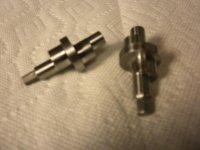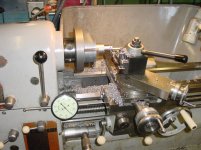Its hard to determine what size the item is. Based on the paper towel design, maybe 2" in length?
Normally camshafts are forged, both to make them stronger and to reduce the amount of metal that needs to be removed. I assume that does not apply here and you are able to just hog off all that metal because the item is so small.
Normally camshafts are hardened, therefore, they are only rough turned and the final dimensions are achieved by grinding after hardening. Since your tolerance is 0.0005" I am guessing the customer wants to skip that step as well and use an unhardened camshaft.
Normally camshafts have cams. The item in question appears to have cylindrical pushers. I will assume you are trying to produce circular profiles, not cams. Therefore, we have a cylindershaft, not a camshaft.

To make a lot of them, you will probably want a fixture and it would be a good idea to turn between centers due to the tight tolerances. Unfortunately, making the fixtures will probably take you nearly as much time as manually turning at least 10 of the items in a four-jawed chuck. The basic procedure is as follows.
1. Turn and face two hot rolled disk plates about 3/8" thick of a diameter sufficient to encompass your needed offset radii. Both plates should fit together well with no visible gaps or rocking. They only need to fit on their faces, the backs are irrelevant.
2. Clamp the plates together, and drill and ream 3x 3/8" holes near the perimeter of the plates equally spaced. Since the plates are clamped together the holes will register the two plates perfectly.
3. Bolt the plates together with 3/8" shoulder screws.
4. Turn the rims of the plates, so they are now exactly the same diameter and the TIR is less than 0.0003".
5. Bore 3 holes through the plates corresponding to the 3 circle offsets you want to turn. These holes are all the same size, the size of your journal. The bores must be a nice press fit to the journals, so you will need to lap them. Note that the holes will overlap, that is ok as long as less than about 60 degrees of the circles overlap. If the overlap is too much, like 120 degrees, then you will need to make a another set of plates.
6. (Optional) Drill holes for attaching balance weights, one for each bore so there will be 3 of them. This will allow the spindle to run with no centrifugal pressure.
Your fixtures are complete.
To use the fixtures:
1. Turn the journals on the workpiece so that the runout is less than 0.0003".
2. Mount faceplates in your both your headstock and tailstock and make sure they are well-aligned.
3. (Optional) Bolt on your counterweights if you decided to do that.
4. Mount the workpiece in the headstock-side fixture either by using an arbor press or by freeze-warming it and tapping it in. Using a press will be much faster.
5. Use pins through your clamping holes to align the tailstock fixture and press the workpiece into that fixture.
6. Mount the fixtures onto your faceplates by bolting them through the clamp holes with shoulder screws.
7. Check the runout at the rims of your fixtures and on the shoulders of the workpiece. If everywhere you have less than 0.0003" of runout, you are good to go. (Obviously, you need a well-adjusted lathe for this to be possible.)
8. Repeat the same steps for the other 2 holes.









 For your app, I would machine the deep collet itself, not use inserts, as that adds yet another stack level if you already have the insert of the collet block.
For your app, I would machine the deep collet itself, not use inserts, as that adds yet another stack level if you already have the insert of the collet block.




